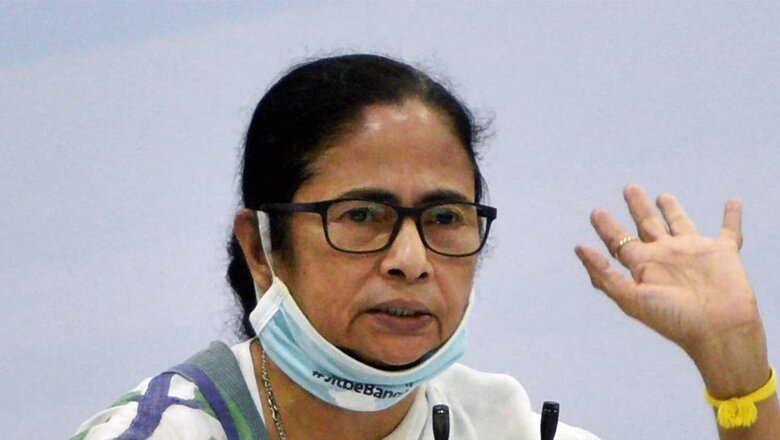
views
West Bengal chief minister and Trinamool Congress chief Mamata Banerjee has been on a roll ever since she registered an emphatic victory against a resurgent Bharatiya Janata Party in a bitterly-fought Assembly election earlier this year.
Having established her dominance in her home state, Mamata Banerjee has decided it is time for her to step out of the confines of West Bengal and expand her party’s footprint across the country to enable her to emerge as the face of a united opposition.
She began by foraying into Tripura in what was supposed to be a test case for Mamata Banerjee but has now expanded into an aggressive poaching spree. The Trinamool Congress (TMC) chief has particularly targeted the Congress in this exercise based on the perception that the grand old party is a pale shadow of its old self and is populated with disgruntled leaders who are on the look-out for greener pastures as they no longer believe in the Gandhi magic. Mamata Banerjee has an advantage with regard to the Congress as she is personally acquainted with a large number of its leaders as she is originally from the grand old party. Not only are these leaders ideologically aligned with Mamata Banerjee, they are also in awe of her.
On Mamata Banerjee’s recent trip to Delhi, the Trinamool Congress witnessed the entry of former Haryana Congress chief Ashok Tanwar, Kirti Azad, formerly with the BJP who subsequently joined the Congress, and former diplomat Pavan Varma, who was a Janata Dal (U) member of the Rajya Sabha and also served as an adviser to Bihar chief minister Nitish Kumar. Earlier, former Mahila Congress chief Sushmita Dev from Assam and Luizinho Faleiro, former Goa chief minister, also from the Congress, joined Mamata Banerjee’s party.
Then there was the coup in Meghalaya where 12 Congress legislators, including former chief minister Mukul Sangma, crossed over to the Trinamool Congress, which overnight acquired the status of the main opposition party in a state where it has no presence. In addition, there are others like tennis star Leander Paes, celebrity Nafisa Ali and retired bureaucrat Jawhar Sircar who are now firmly ensconced in the Trinamool Congress.
This spate of inductions has naturally grabbed headlines but a closer look at the list of leaders and celebrities who have joined the Trinamool Congress tells a different story. With the exception of Sushmita Dev who has the potential of winning an election, the others bring little to the table, having virtually no political presence in their respective states. For instance, Ashok Tanwar may be a Dalit face and was once close to Congress leader Rahul Gandhi but he is unlikely to help in the expansion of the Trinamool Congress in Haryana. Ditto for Kirti Azad and Pavan Varma in Bihar.
In that case, what is Mamata Banerjee’s game plan? As a shrewd, street-smart politician, she is obviously aware of the limitations of the leaders who have joined her party. It is evident that it is a well thought-out strategy, crafted by her adviser Prashant Kishor, to first create a buzz about how leaders from different states and political parties are gravitating towards the TMC because they are convinced that only Mamata Banerjee has the capability, as proved by her West Bengal victory, to challenge Prime Minister Narendra Modi. It is essentially all about optics which, the Trinamool Congress strategists surmise, will lead to further desertions from the Congress because there is a large section in the party which is convinced that Rahul Gandhi does not have it in him to take on Modi. Once Mamata Banerjee enlists leaders across the country, the next step is to pick up a few seats in states outside West Bengal so that the TMC can acquire the status of a national party.
While the poaching of leaders continues, Mamata Banerjee is also reaching out to other regional parties like the Shiv Sena and the Samajwadi Party to explore the possibility of putting together an anti-BJP grouping with an eye on the 2024 Lok Sabha polls. Though it has been accepted so far that as a national party, the Congress will be the lead player of any such front, Mamata Banerjee is obviously positioning the Trinamool Congress for that role since the grand old party has proved singularly ineffective in fighting the BJP. It would appear that the objective here is to present the Congress with a fait accompli so that it is forced to accept a secondary role in this proposed anti-BJP front or else it would be accused of wrecking opposition unity.
Even as Mamata Banerjee aims to occupy the Congress space, it will not be easy for the Trinamool Congress to become electorally viable in states where it has no social base, no local leaders or a party organisation. Mere optics will not suffice as she must have a roster of credible leaders who can win elections and, at the same time, offer an ideological alternative to the electorate. Mere BJP-bashing will not do.
As Mamata Banerjee goes about the task of spreading her wings, the BJP is not overtly worried over these developments for she is completing the task it set out to do when it came to power in 2014: wiping out the Congress. The BJP has always been more comfortable dealing with regional parties as most of them, with the exception of the Rashtriya Janata Dal (RJD), have done business with it in the past. Not only are these parties ideologically flexible but they are primarily focused on the interests of their respective states and can be mollified with the allocation of extra funds and sanction of special projects.
Mamata Banerjee’s eventual target may be the BJP but, for the moment, it is the Congress which should be worried.
The author is a senior journalist. The views expressed in this article are those of the author and do not represent the stand of this publication.
Read all the Latest Opinions here


















Comments
0 comment